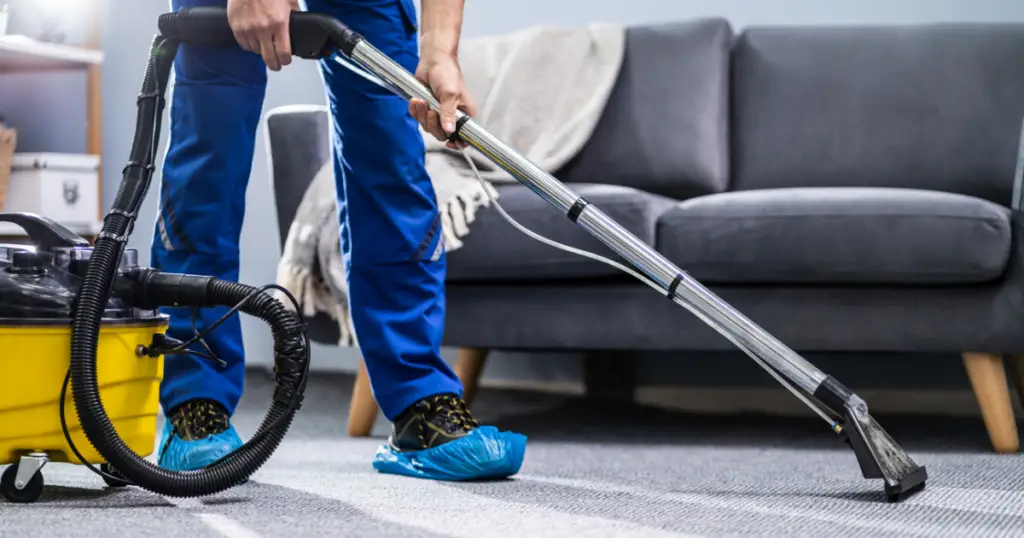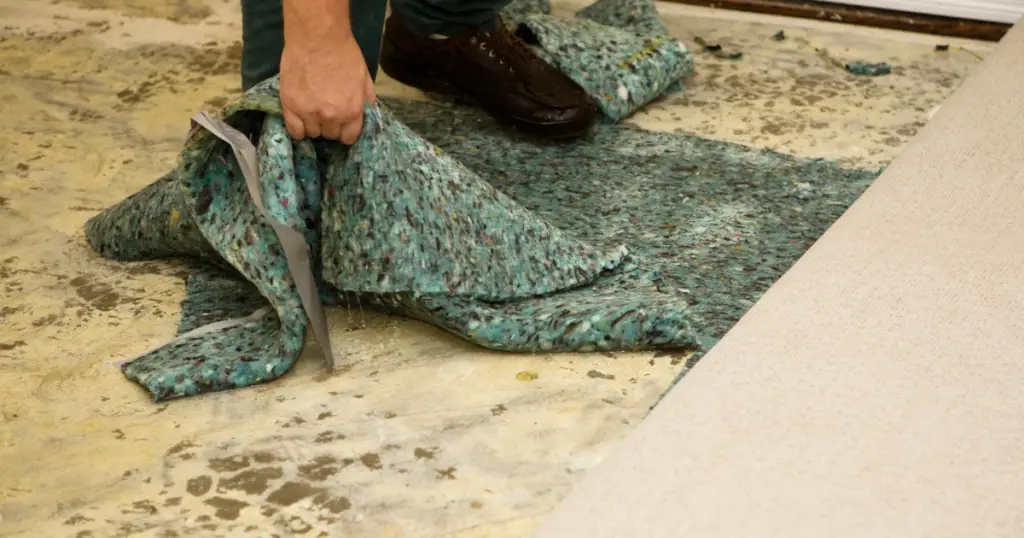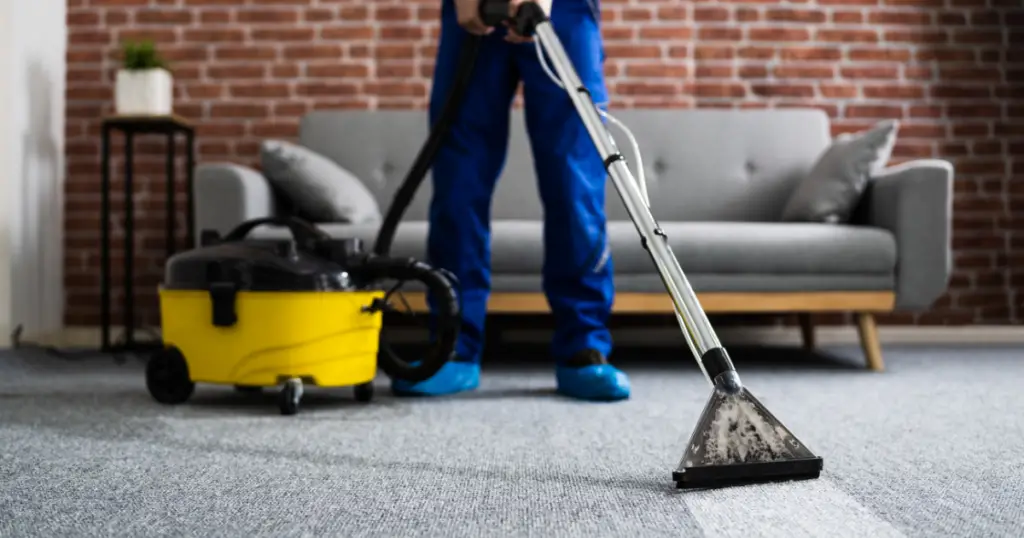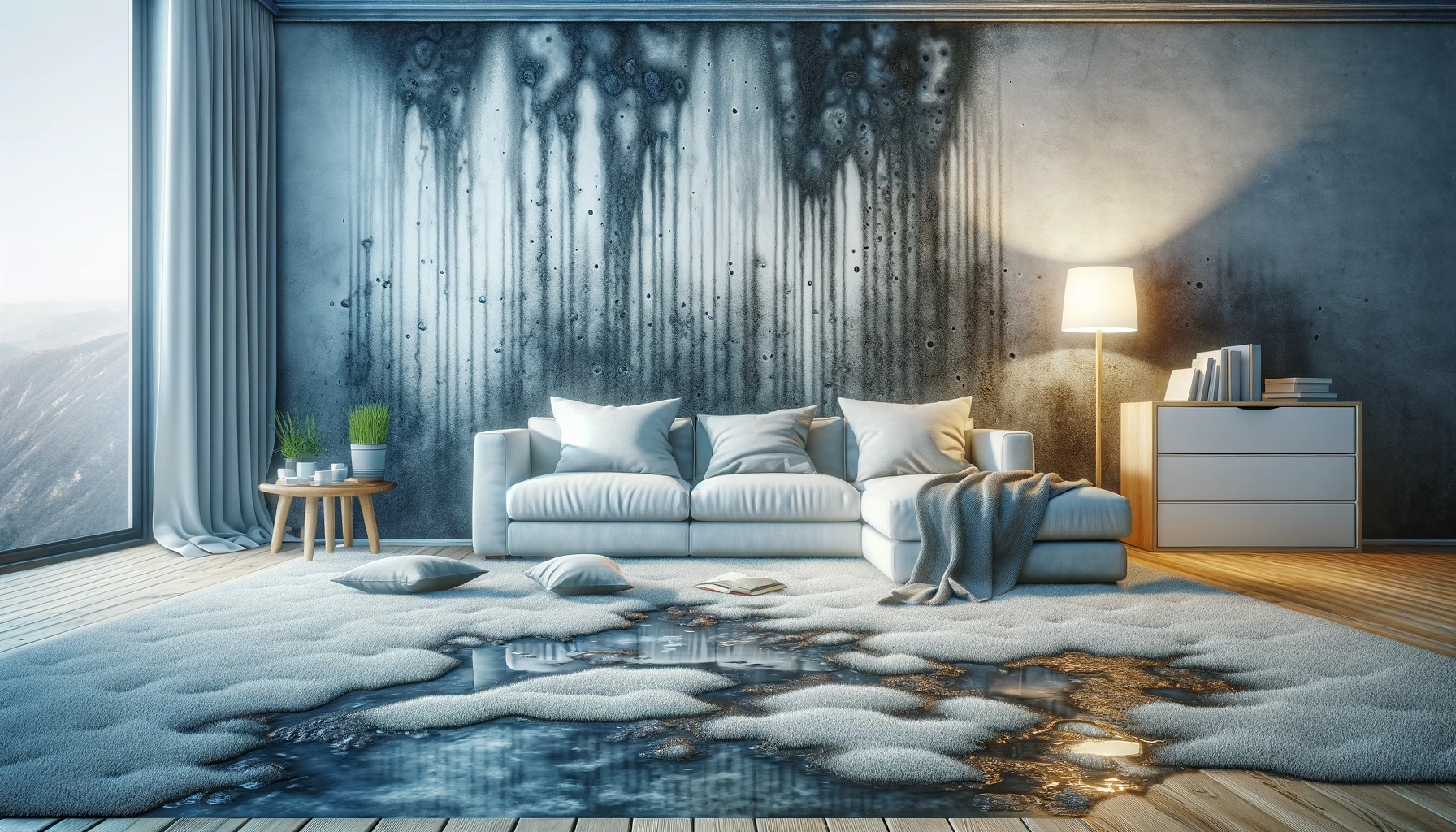Water damage in carpets can occur anytime, from broken pipes to overflowing toilets. Porous materials quickly absorb moisture, leading to warping, discoloration, and other kinds of damage. To prevent the spread of mold and mildew growth, structural problems, and health issues, it is essential to understand the steps needed to address and resolve water-damaged carpets.
What does water damage look like on the carpet?
Carpet is a great addition to any home, but it can be an expensive investment. In many cases, the damage from water on the carpet is not always immediately visible. Here are some signs of water damage you should look out for in your carpets:
- Discoloration: Water spills can cause deeply stained spots that may have an unusual color or texture.
- Fraying: Seam edges may start to fray or curl as a result of dampness and moisture seeping in through the fibers.
- Matting: The carpet fibers may become flattened due to saturation or too much foot traffic over them while they are wet.
- Odor: If the affected area doesn’t dry up quickly enough, it will begin to give off a musty odor.
If you notice any of these signs of water damage on your carpet, act quickly to address the issue before it becomes more severe and costly.

What do I do immediately if my carpet gets wet?
If your carpet gets wet, you must act quickly to address the issue. Depending on the source of the water and how much is there, the steps you take may vary. Here are a few things to consider if your carpet gets wet:
- Address the Situation: Identify where the water or liquid is coming from, such as sewage, leaking pipes, etc., so you can stop any further damage from occurring.
- Wear Protection: If you are dealing with contaminated water, it is highly recommended to put on protective gear such as boots and gloves before touching any water-damaged areas, as this may contain hazardous materials that could be harmful if not handled properly.
- Clear the Room: Move furniture and other items away from the wet area to prevent mold growth or other complications from prolonged contact with moisture.
- Fix the leak: Whether the cause of the leak is a broken pipe, a leaking roof, or another issue, you have to get that fixed before beginning the drying process. If possible, repair any leaks that caused the carpet to get wet to prevent future damage from occurring. You should also contact a local flood cleanup specialist for assistance pumping out standing/flowing water from your home if applicable.
- Sewage: If the carpet has been affected by sewage, it is important to seek professional help as the contaminated area needs to be treated differently than regular spills.
- Limit Traffic on Wet Carpet: Avoid walking on or damaging a soaked area until it is completely dry, as this can further weaken and deteriorate fibers in the carpet, resulting in more wear and tear than necessary over time.
- Airflow: Increase airflow in the room by opening windows and/or running fans. This will help accelerate the drying process so you can begin repairing your carpet sooner rather than later.
- Clean it: Once you have addressed all of these concerns, use a mild cleaning solution (such as white vinegar or baking soda) along with a soft cloth or sponge to gently scrub away dirt and bacteria left behind by standing water on your carpeting. Allow it to dry completely before replacing furniture or covering it up with rugs/mats again.*
- Professional Help: If the water-damaged area is too large or you are unsure of how to address it properly, consider hiring a professional cleaning company specializing in carpet restoration to assist you.

Can the carpet be cleaned after water damage?
The answer to whether or not a carpet can be cleaned after water damage depends on the severity of the situation. If there has been minimal water spillage, then it is likely that the area can be saved with proper cleaning and drying.
However, if the water damage is extensive (such as in cases of flooding or sewage), then it is important to act quickly to prevent much more serious problems such as mold and bacteria growth which could put your health at risk.
Therefore, you should assess the extent of the water damage before attempting any cleanup. Depending on how wet and contaminated the area is, you may need to call professional help to get your carpets back into proper condition.

Water-Damaged Carpet Cleaning Process
Cleaning a carpet after water damage is not an easy process and requires patience, but if done properly it can help prevent further damage and restore your carpets to their original condition. Here is a step-by-step guide on how to go about it:
- Protective Gear: Put on gloves and boots before attempting any cleaning as this will ensure your safety from hazardous materials often present in cases of water damage.
- Evaluate damage and assess furniture and Materials: Carefully examine the carpeting for any harm and observe any furniture or other components that could have been impacted by water. If you have furnishings and fixtures in the room, make sure to determine whether they experienced moisture damage. While some items can be taken out, dried off, and restored; others – like upholstered furniture – may require a more delicate approach. Regrettably, you might need to discard objects with extreme water destruction.
- Remove the moisture: Use a wet/dry vacuum cleaner to get rid of any standing water or sewage flooding, depending on the severity of the situation. If you don’t have access to a wet/dry vacuum cleaner, use towels or sponges instead to sop up as much liquid as possible before moving on to the next step.
- Increase air circulation: Open doors and windows in the room where the water has damaged your carpeting for proper ventilation – this will help speed up drying time significantly. You could also place fans near affected areas to increase airflow even more efficiently.
- Get cleaning: Sprinkle baking soda onto wet surfaces to soak up trapped moisture while disinfecting at the same time – do not forget to use a regular vacuum cleaner to remove any residue left behind once it dries completely! Use a mild cleaning solution (such as dish soap and baking soda) along with a soft cloth or sponge to gently scrub dirt and bacteria left behind by standing water on your carpets if needed.
- Steam Clean: After a carpet has been wet for too long, toxins and odors can arise. To eliminate them both, steam cleaning is the ideal solution: it’s effective at penetrating deep into carpets to kill mold spores and other contaminants and vacuums these away. You can try doing this yourself or call a professional to help. The high temperature of the steamer ensures that any potential health hazards are eliminated safely.
- Disinfect all surfaces: To ensure total protection, you might opt to utilize a commercial disinfectant on all areas of your home and carpets that have been impacted by water damage. This specialized product is formulated with the highest quality materials for maximum safety.
- Replace the padding: Once everything is cleaned and disinfected, you may need to replace the soaked carpet padding if it has been soaked through with water. This will help prevent mold growth and other issues related to moisture buildup.
- Monitor the area for moisture: Regularly check for any signs of moisture in the room where the flooded carpet was located to ensure that all water has been successfully eliminated and the area is again dry.
Water damage can be an overwhelming task, however, with a bit of know-how and effort, you can restore your carpets and get back to enjoying the comfort of a clean and safe home.
Drying Options and Processes
After the cleaning process, it is critical to monitor and maintain consistent moisture levels in your home for full assurance that your carpet is free from dampness. Here are some strategies you can employ:
- Fan: Air dry your place with fans near wet areas to increase airflow and speed up drying time significantly.
- Dehumidifier: Setting up a dehumidifier in the same room as the one that has been damaged can help reduce humidity levels and absorb any remaining moisture in the air – this is especially useful during humid conditions! Change the filter once every two weeks, depending on usage frequency.
- Heater: Heat naturally helps evaporate moisture faster, so cranking up the thermostat can help speed up drying time even more quickly than fans alone would do.
- Open Windows: Opening windows also increase air circulation, which will expedite the drying process considerably if appropriately done with caution (considering wind direction). Note that you should never place fans directly facing open windows as this will create an airflow loop that could worsen damage instead of helping it improve!
What not to do?
When it comes to water-damaged carpets, there are certain things that you should avoid doing. Here is a list of what not to do when dealing with water damage:
- Avoid using vinegar on carpet stains or areas of water damage. Utilizing vinegar on your carpets can be counter-productive, as it contains an acidic compound that has the potential to damage and discolor fibers.
- Avoid using products that mask odors. These products don’t remove the source of the odor and can make matters worse by contributing to long-term smells and health issues over time.
- Do not leave damaged materials in place for an extended period. If possible, take measures to remove wet items from the premises as soon as you can – this will help prevent further deterioration due to dampness or mold growth within affected areas of your home.
How long does the carpet dry after a water leak take?
The time it takes for your carpets to dry completely after a water leak depends on several factors, including:
- How wet your carpet got: The more soaked the carpets are, the longer it will take for them to be completely dry.
- The carpet type: Thick or plush carpets tend to retain more moisture and may take longer to dry than thinner carpets.
- What method you used to extract excess water: If you used a shop vacuum or wet vacuum cleaner to remove large amounts of standing water from the affected area, this will dramatically reduce the amount of drying time needed. Additionally, using fans and dehumidifiers will help accelerate the process as well.
However, on average, it can take between 24-48 hours for carpets to fully dry after a water leak or flood has occurred – though some extreme circumstances could require additional time depending on factors outside your control.
Should a wet carpet padding or rug be replaced after water damage?
Whether or not a carpet or rug should be replaced after water damage depends on the extent of the damage and the type of materials it is made of. Generally speaking, if the material is made of natural fibers such as wool, it may need to be replaced due to its tendency to shrink when wet. Synthetic materials such as polyester and nylon are usually much more resistant to moisture and can often be dried out without needing to be replaced.
How fast does mold start to grow in wet carpets?
Mold starts its growth in a water damaged carpet quickly, depending on the environmental conditions. Generally, if the temperature is between 77-86°F (25-30 °C) and humidity levels are above 60%, mold spores may start to grow within 24 to 48 hours, or even faster if sufficient organic material is present. However, cooler temperatures, dry air, and low levels of organic debris can significantly slow the growth process.
How do I know if my carpet pad has mold?
The best way to determine if mold is present on a carpet pad is to inspect it closely with bright lighting and a magnifying glass. Mold growth usually appears as dark spots, with some varieties of colors like green and pink, and has a fuzzy texture.
Additionally, if you’ve noticed an unpleasant musty smell near the carpet pad, there is likely mold present in the area. Removal of the carpet pad should be done as soon as possible to contain the spread of any mold colonies that may be growing. Since flood water also contains bacteria and other contaminants, it’s important to take all necessary safety measures when dealing with this type of situation.
Professional Carpet Cleaning
When dealing with significant water damage to carpeting, it’s best to seek professional help for an effective solution. Professional carpet cleaning services specialize in restoring carpets that have been damaged by flooding, spills, or general wear and tear. In addition to removing dirt, dust, and debris from the material, these services can employ powerful filtration systems to extract excess moisture buildup and restore the areas affected by water damage.
[/et_pb_text][/et_pb_column][/et_pb_row][/et_pb_section]



